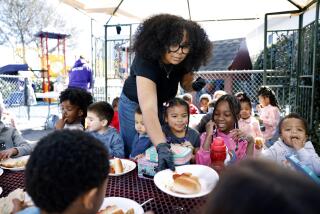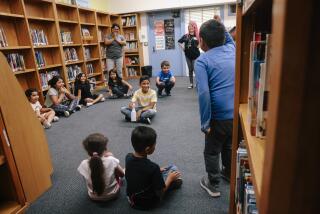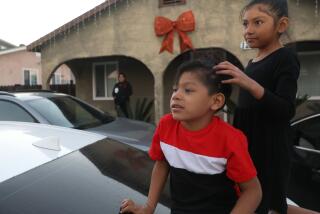A loophole is allowing thousands of California students to use pandemic-shuttered classrooms
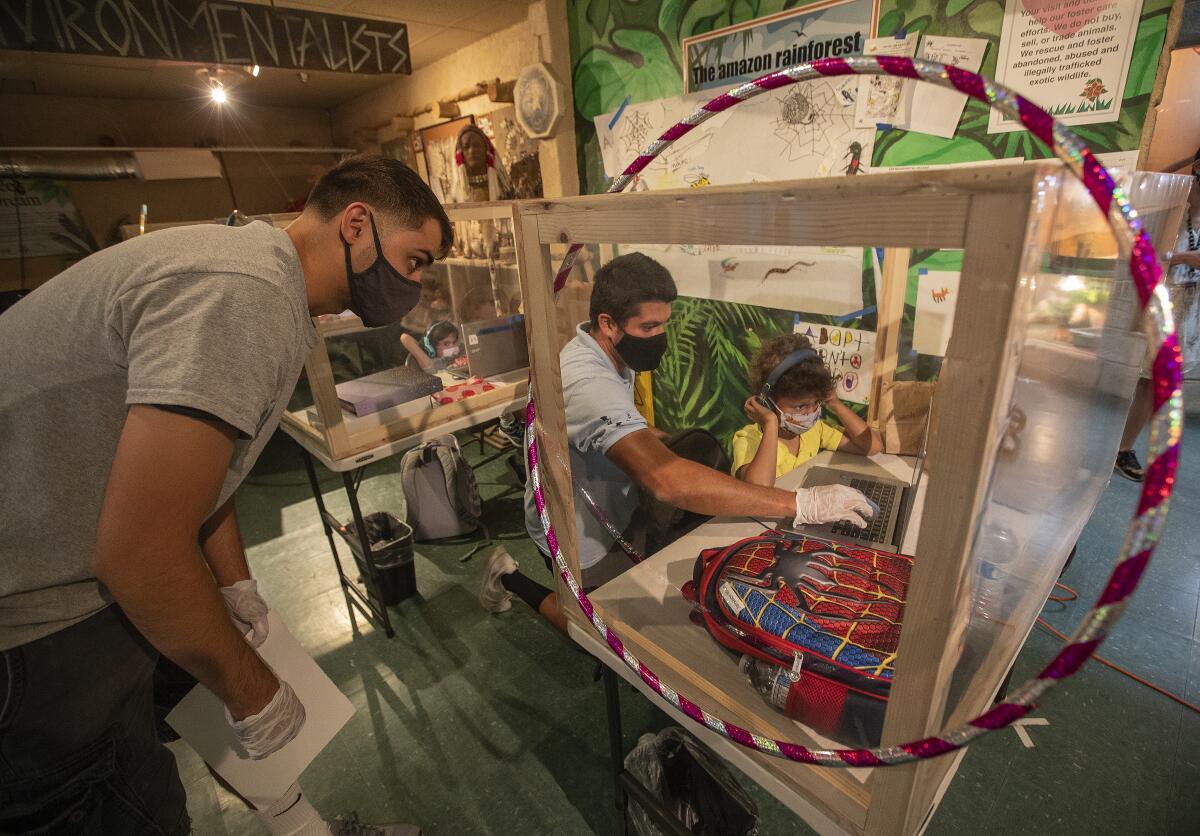
Five-year-old Jameson Miniex twisted his fingers into his curly hair, watching with rapt attention as a teacher in a blush-colored hijab read a book for the first day of school.
Around him, other Los Angeles Unified School District kindergartners scribbled their assignments and stretched their hands in the air, each working behind a clear plastic partition that is now as much a part of school’s visual lexicon as milk pints and chalkboards.
But these L.A. students aren’t back in school. Instead, they’ve joined thousands of youngsters who log into class from day camps and tutoring programs such as this one — many alongside their pre-COVID classmates, and some in the very classrooms that were shuttered by the pandemic.
“We were one of the first in the state to provide camps to the children of first responders,” said Sir Robinson, co-director of camps for STAR Education, the academic nonprofit that runs Jameson’s program and others like it around the state. “Now we’re acquiring new buildings and making sure they can hold the highest number of children as safely as possible.”
Like all child care, day camps are considered essential in California. But with school starting remotely and private tutors reserved for a rarified few, many public school children have returned to modified summer camps and after-school programs for the fall, in what professor Artineh Samkian of USC Rossier School of Education called “a middle-class version” of expensive backyard pods. In many cases, what were once their classrooms have been converted into day cares for the children of district employees, while many private schools have transformed into camps for the term.
“Each one of these instances is unique and distinctive,” Gov. Gavin Newsom said when asked about such programs at a news conference Wednesday. “There’s over 1,000 school districts in this state. ... You’re going to see people testing the boundaries of some of these state orders.”
In fact, experts said, the workarounds appear common and increasingly uniform — and it’s unclear that any of them run afoul of state rules. That’s because day camps are virtually unregulated in California. Like tutoring and enrichment programs, most are exempt from licensing requirements, at least for part of each year, and it’s not clear how officials would know when those exemptions expire. The state Department of Social Services, which licenses most other forms of child care, has no record of how many day camps there are or how many children attend them. Neither does the L.A. County Department of Health, which is responsible for ensuring that those camps follow coronavirus safety rules.
“Los Angeles County Department of Public Health does not regulate, permit, or approve the operation of day camps,” outside of inspecting things such as swimming pools and food service, a department representative wrote in an email. While DPH “can require adherence” to pandemic precautions, “there is no state or local licensing required” for camps.
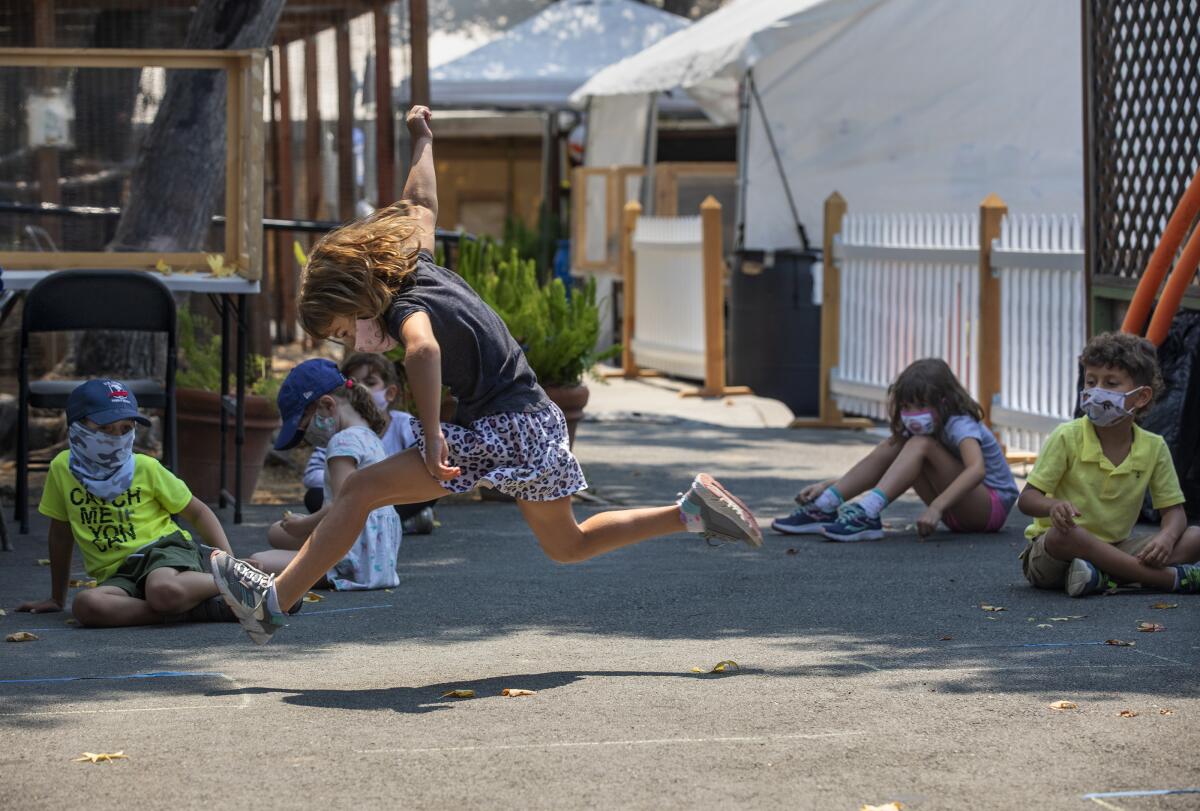
On Wednesday, Newsom thanked officials for “their enforcement in this space,” without clarifying what, if any, enforcement had occurred. Most license-exempt programs bill themselves as strictly observing social distancing and sanitation protocols, the health department’s primary purview. (Some also feature lengthy contagion-specific liability waivers.)
And while unlicensed camps could face fines if they operate beyond the 12-week exemption period — an epoch in 2020 time — the agency that would fine them is simultaneously responsible for hundreds of thousands of children in day cares and preschools, 60,000 more in foster care, and 400,000 Californians in nursing homes.
“Community Care Licensing doesn’t really have the bandwidth to enforce that,” said Kim Kruckel, executive director of the Child Care Law Center. “There’s only so many people to deal with so many crises.”
Some teachers worry that private schools may reopen as “camp” in name only, violating the governor’s July 17 executive order. A Cal/OSHA spokeswoman said the agency could investigate specific workplace safety complaints — rooms with more than 12 children, for example, or lax enforcement of mask rules — but it has no more power over the operation of license-exempt programs than social services or the health department. Without licensing, there’s little to say what a camp is or isn’t. Even licensed day-care programs such as those run by school districts look little different from school.
Meanwhile, demand from working parents has surged.
“Parents are panicked, because [remote learning] did not work out for them in the spring,” said STAR Education founder Katya Bozzi, who now spends her days cold-calling churches and scouting out parking lots in search of space for the 1,200 children on her waitlist. “They’re basically either crying on the phone or they’re venting or they’re completely lost. Somebody has to help the kids with school, and the parents have to work.”
Some, like nurse Elizabeth Diep, are single parents with essential jobs. Others can no longer balance remote work and Zoom school; they feel they’ve been given an impossible choice between their present livelihoods and their children’s academic future.
“It reached the point when families said to us, we don’t know if our school’s going back, we don’t know when, could you add a few weeks more?” said Brian Greene, executive director of the Westside Jewish Community Center. “If the parents need us, we would like to be there for them.”
Like the students at STAR, JCC campers bring their own device and headphones, and are helped to log into classes being livestreamed from their various schools and complete their assignments in a space set aside for that purpose. But while Jameson and other STAR students do worksheets or calisthenics between their online classes, JCC campers weave friendship bracelets and skip rope and play guitar — exactly as they did through the summer.
“That’s the same model we’re going to use through the school year,” said Angelika Getmanchouk, head of school at WorldSpeak, a private elementary school in Westwood that reopened as a camp in May. “Whatever needs to be done, you just roll up your sleeves and you do it.”
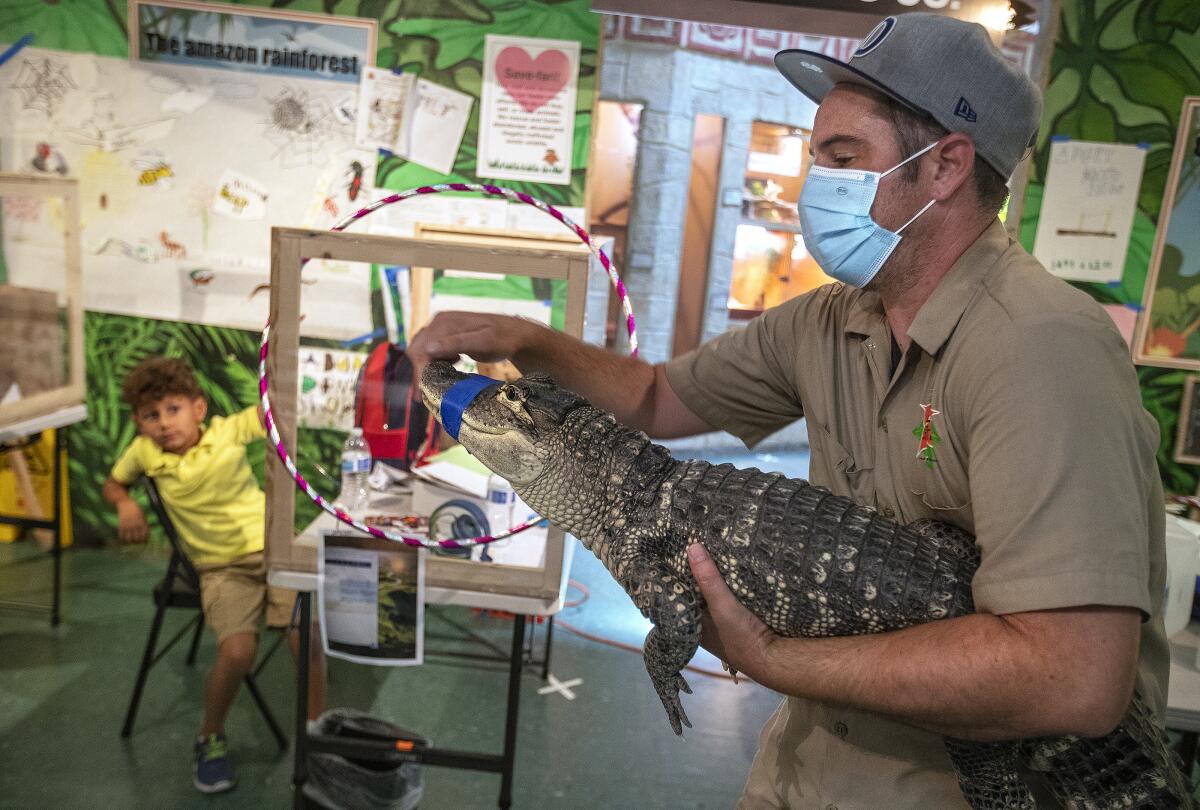
Public schools, too, have scrambled to provide in-person help for some parents. Glendale Unified School District has substitute teachers running classrooms for the neediest tenth of its 13,000 elementary schoolers. LAUSD has opened “supervision centers” to manage online instruction for the children of its employees, using workers from its after-school programs.
“This is child care at its best, because we’re lifting the burden off the shoulders of families who have been desperately seeking child care but can’t afford it,” said Glendale Supt. Vivian Ekchian. “The reality is we have high school kids who are left in charge of supervising their younger siblings. It’s not a good way to allow anyone to learn.”
But her district is unique. To serve the same proportion of LAUSD elementary school students would require more than 2,500 classrooms and at least as many educators — equivalent to more than 10% of the district’s entire K-12 teacher corps. Many of those resources are already being used to support the children of teachers and other district staff, leaving public school families to pay out of pocket for the care they need, if they can afford care at all.
“Even a minimal fee is problematic,” said Samkian, the USC professor. “Even though it might seem nominal, when you add multiple siblings and many, many months, it is really cost-prohibitive.”
That’s what happened to Diep, the nurse, who spent the summer working with critically ill COVID patients in Redlands. Her two children have been in a Boys and Girls Club camp from 7 a.m. to 5:30 pm. every weekday since April, but at $150 per child per week — a steal by summer camp standards — the cost has become unsustainable.
“I’m taking on a second full-time job to pay for it,” she said. “My second job will be in the ER. I’ll be working on the weekends through the winter.”
For her and many others, camps fill a desperate need. But the more of them that open, and the longer they run, the more frustrated she feels.
“My children have been in day camp since April 6 and they have not gotten sick,” either with coronavirus or the constant colds and stomach bugs they used to bring home, Diep said. “If a day camp is able to do it, why couldn’t the school?”
More to Read
Sign up for Essential California
The most important California stories and recommendations in your inbox every morning.
You may occasionally receive promotional content from the Los Angeles Times.

